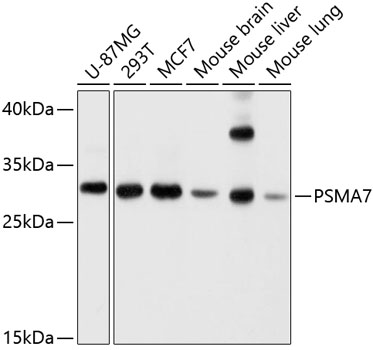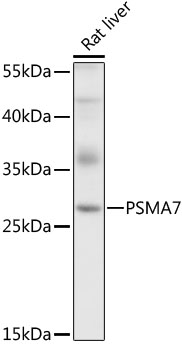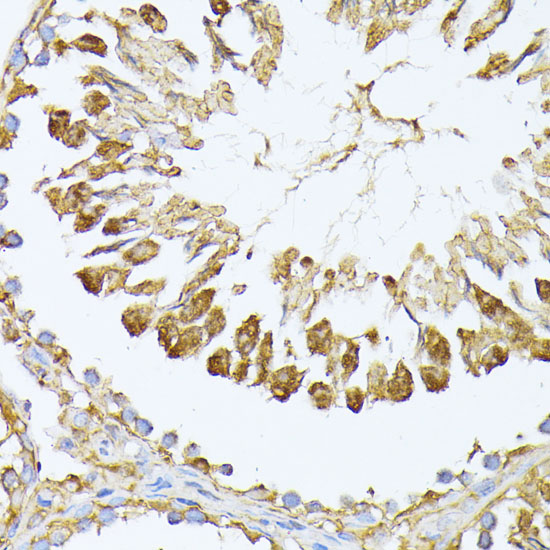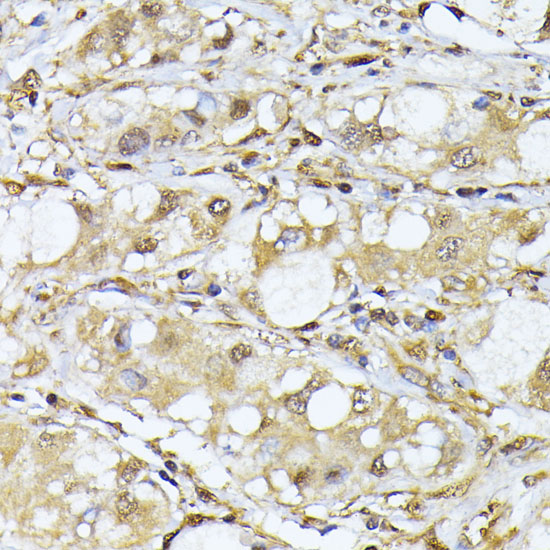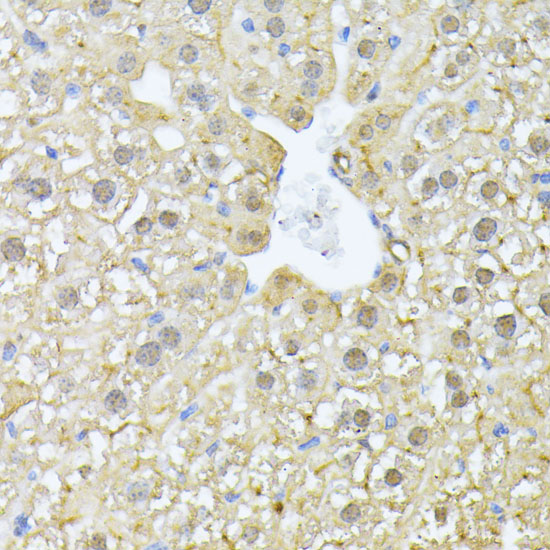Anti-PSMA7 Antibody (CAB4052)
- SKU:
- CAB4052
- Product type:
- Antibody
- Reactivity:
- Human
- Reactivity:
- Mouse
- Reactivity:
- Rat
- Host Species:
- Rabbit
- Isotype:
- IgG
- Research Area:
- Immunology
Description
| 抗体名: | Anti-PSMA7 Antibody |
| 抗体コード: | CAB4052 |
| 抗体サイズ: | 20uL, 50uL, 100uL |
| 申し込み: | WB IHC IF |
| 反応性: | Human, Mouse, Rat |
| 宿主種: | Rabbit |
| 免疫原: | Recombinant fusion protein containing a sequence corresponding to amino acids 1-248 of human PSMA7 (NP_002783.1). |
| 申し込み: | WB IHC IF |
| 推奨希釈: | WB 1:500 - 1:2000 IHC 1:50 - 1:100 IF 1:50 - 1:100 |
| 反応性: | Human, Mouse, Rat |
| ポジティブサンプル: | U-87MG, 293T, MCF7, Mouse brain, Mouse liver, Mouse lung, Rat liver |
| 免疫原: | Recombinant fusion protein containing a sequence corresponding to amino acids 1-248 of human PSMA7 (NP_002783.1). |
| 精製方法: | Affinity purification |
| ストレージバッファ: | Store at -20'C. Avoid freeze / thaw cycles. Buffer: PBS with 0.02% sodium azide, 50% glycerol, pH7.3. |
| アイソタイプ: | IgG |
| 順序: | MSYD RAIT VFSP DGHL FQVE YAQE AVKK GSTA VGVR GRDI VVLG VEKK SVAK LQDE RTVR KICA LDDN VCMA FAGL TADA RIVI NRAR VECQ SHRL TVED PVTV EYIT RYIA SLKQ RYTQ SNGR RPFG ISAL IVGF DFDG TPRL YQTD PSGT YHAW KANA IGRG AKSV REFL EKNY TDEA IETD DLTI KLVI KALL EVVQ SGGK NIEL AVMR RDQS LKIL NPEE IEKY VAEI EKEK EENE KKKQ KKAS |
| 遺伝子ID: | 5688 |
| Uniprot: | O14818 |
| セルラーロケーション: | Cytoplasm, Nucleus |
| 計算された分子量: | 16kDa/20kDa/27kDa |
| 観察された分子量: | 30kDa |
| 同義語: | PSMA7, C6, HEL-S-276, HSPC, RC6-1, XAPC7 |
| バックグラウンド: | The 26S proteasome is a multicatalytic proteinase complex with a highly ordered structure composed of 2 complexes, a 20S core and a 19S regulator. The 20S core is composed of 4 rings of 28 non-identical subunits; 2 rings are composed of 7 alpha subunits and 2 rings are composed of 7 beta subunits. Proteasomes are distributed throughout eukaryotic cells at a high concentration and cleave peptides in an ATP/ubiquitin-dependent process in a non-lysosomal pathway. This gene encodes a member of the peptidase T1A family that functions as a 20S core alpha subunit. The encoded protein interacts with the hepatitis B virus X protein and plays a role in regulating hepatitis C virus internal ribosome entry site (IRES) activity, an activity essential for viral replication. The encoded protein also plays a role in the cellular stress response by regulating hypoxia-inducible factor-1alpha. A pseudogene of this gene is located on the long arm of chromosome 9. |
| UniProt Protein Function: | PSMA7: The proteasome is a multicatalytic proteinase complex which is characterized by its ability to cleave peptides with Arg, Phe, Tyr, Leu, and Glu adjacent to the leaving group at neutral or slightly basic pH. The proteasome has an ATP-dependent proteolytic activity. Plays an important role in the regulation of cell proliferation or cell cycle control, transcriptional regulation, immune and stress response, cell differentiation, and apoptosis. Interacts with some important proteins involved in transcription factor regulation, cell cycle transition, viral replication and even tumor initiation and progression. Inhibits the transactivation function of HIF-1A under both normoxic and hypoxia-mimicking conditions. The interaction with EMAP2 increases the proteasome-mediated HIF-1A degradation under the hypoxic conditions. Plays a role in hepatitis C virus internal ribosome entry site-mediated translation. Mediates nuclear translocation of the androgen receptor (AR) and thereby enhances androgen-mediated transactivation. Promotes MAVS degradation and thereby negatively regulates MAVS-mediated innate immune response. The 26S proteasome consists of a 20S proteasome core and two 19S regulatory subunits. The 20S proteasome core is composed of 28 subunits that are arranged in four stacked rings, resulting in a barrel-shaped structure. The two end rings are each formed by seven alpha subunits, and the two central rings are each formed by seven beta subunits. The catalytic chamber with the active sites is on the inside of the barrel. PSMA7 interacts directly with the PSMG1-PSMG2 heterodimer which promotes 20S proteasome assembly. Interacts with HIV-1 TAT protein. Interacts with hepatitis B virus X protein (HBX). Interacts with HIF1A. Interacts with RAB7A. Interacts with PARK2. Interacts with ABL1 and ABL2. Interacts with EMAP2. Interacts with MAVS. Down-regulated by the ribozyme Rz3'X. Up-regulated in colorectal cancer tissues. Belongs to the peptidase T1A family. 3 isoforms of the human protein are produced by alternative splicing. |
| UniProt Protein Details: | Protein type:Proteasome complex; EC 3.4.25.1; Protease Chromosomal Location of Human Ortholog: 20q13.33 Cellular Component: nucleoplasm; proteasome complex; proteasome core complex; nucleus; cytosol Molecular Function:threonine endopeptidase activity; identical protein binding; protein binding Biological Process: positive regulation of ubiquitin-protein ligase activity during mitotic cell cycle; negative regulation of ubiquitin-protein ligase activity during mitotic cell cycle; protein polyubiquitination; viral reproduction; apoptosis; antigen processing and presentation of exogenous peptide antigen via MHC class I, TAP-dependent; DNA damage response, signal transduction by p53 class mediator resulting in cell cycle arrest; regulation of apoptosis; antigen processing and presentation of peptide antigen via MHC class I; regulation of ubiquitin-protein ligase activity during mitotic cell cycle; anaphase-promoting complex-dependent proteasomal ubiquitin-dependent protein catabolic process; antigen processing and presentation of exogenous peptide antigen via MHC class I; gene expression; mitotic cell cycle; regulation of amino acid metabolic process; negative regulation of apoptosis; G1/S transition of mitotic cell cycle |
| NCBI Summary: | The 26S proteasome is a multicatalytic proteinase complex with a highly ordered structure composed of 2 complexes, a 20S core and a 19S regulator. The 20S core is composed of 4 rings of 28 non-identical subunits; 2 rings are composed of 7 alpha subunits and 2 rings are composed of 7 beta subunits. Proteasomes are distributed throughout eukaryotic cells at a high concentration and cleave peptides in an ATP/ubiquitin-dependent process in a non-lysosomal pathway. This gene encodes a member of the peptidase T1A family that functions as a 20S core alpha subunit. The encoded protein interacts with the hepatitis B virus X protein and plays a role in regulating hepatitis C virus internal ribosome entry site (IRES) activity, an activity essential for viral replication. The encoded protein also plays a role in the cellular stress response by regulating hypoxia-inducible factor-1alpha. A pseudogene of this gene is located on the long arm of chromosome 9. [provided by RefSeq, Jul 2012] |
| UniProt Code: | O14818 |
| NCBI GenInfo Identifier: | 12643540 |
| NCBI Gene ID: | 5688 |
| NCBI Accession: | O14818.1 |
| UniProt Secondary Accession: | O14818,Q5JXJ2, Q9BR53, Q9H4K5, Q9UEU8, B2R515, |
| UniProt Related Accession: | O14818 |
| Molecular Weight: | 248 |
| NCBI Full Name: | Proteasome subunit alpha type-7 |
| NCBI Synonym Full Names: | proteasome (prosome, macropain) subunit, alpha type, 7 |
| NCBI Official Symbol: | PSMA7 |
| NCBI Official Synonym Symbols: | C6; HSPC; RC6-1; XAPC7 |
| NCBI Protein Information: | proteasome subunit alpha type-7; proteasome subunit RC6-1; proteasome subunit XAPC7; proteasome subunit alpha 4 |
| UniProt Protein Name: | Proteasome subunit alpha type-7 |
| UniProt Synonym Protein Names: | Proteasome subunit RC6-1; Proteasome subunit XAPC7 |
| Protein Family: | Proteasome |
| UniProt Gene Name: | PSMA7 |
| UniProt Entry Name: | PSA7_HUMAN |


